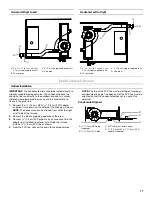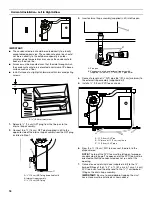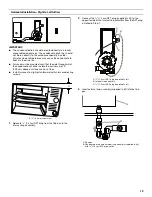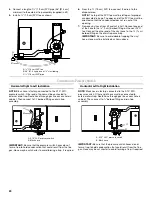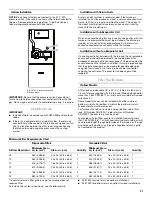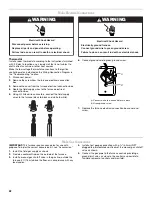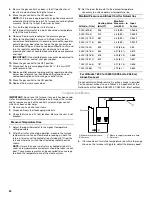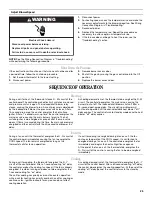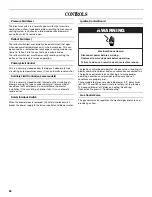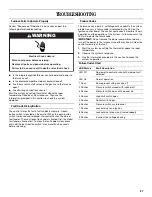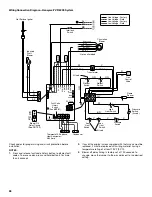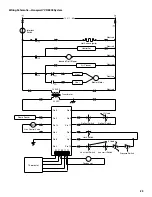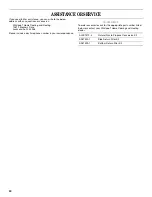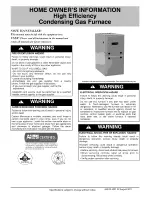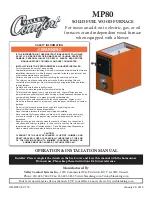
23
Pipe-joint compounds suitable for use with Natural and LP
gas must be used. Do not use Teflon
®
tape.
6. Turn off the gas supply at the manual gas shutoff valve.
7. Remove the inlet pressure tap plug on the gas control valve
and connect pressure gauge to the
¹⁄₈
" NPT inlet
pressure tap.
8. Turn on the gas supply at the manual gas shutoff valve.
9. Observe the inlet pressure.
The minimum inlet gas supply pressure is 5" (12.7 cm) W.C.
for Natural gas and 11" (27.9 cm) W.C. for propane gas.
The maximum inlet gas supply pressure is 10
¹⁄₂
" (26.7 cm)
W.C. for Natural gas and 13" (33 cm) W.C. for propane gas.
10. Turn off the gas supply at the manual gas shutoff valve.
IMPORTANT: If the inlet gas supply pressure is not within the
minimum and maximum range as shown on the rating plate,
contact your gas supplier.
11. Disconnect the pressure gauge from the
¹⁄₈
" (3.2 mm) NPT
inlet pressure tap.
12. Replace the inlet pressure tap plug on the gas control valve.
13. Turn on the gas supply at the manual gas shutoff valve.
14. Test all connections by brushing on an approved
noncorrosive leak-detection solution. Bubbles will show a
leak. Correct any leak found.
■
At test pressures greater than
¹⁄₂
psig (3.5 kPa), the
furnace and the manual gas shutoff valve must be
disconnected from the gas supply piping system.
■
At test pressures less than or equal to
¹⁄₂
psig (3.5 kPa),
the furnace must be isolated from the gas supply piping
system by closing the manual gas shutoff valve.
15. Replace the burner access door.
Check the Furnace Input Rate
(if required)
IMPORTANT:
■
The furnace input rate must not exceed the input rating on
the furnace rating plate.
■
This furnace is equipped for rated input at manifold pressures
of 3
¹⁄₂
" (8.9 cm) W.C. for natural gas and 10" (25.4 cm) W.C.
for propane gas.
■
For natural gas, check the furnace rate by observing the gas
meter, making sure all other gas appliances are turned off.
The test hand on the meter should be timed for at least one
revolution.
■
At altitudes from 2,000 to 7,500 ft (609.6 m to 2,286 m) the
furnace input rate must not exceed that on the rating plate.
NOTE: The actual heating value of your gas can be obtained from
your local utility company. Typical values are shown in the
Manifold Pressure vs. Altitude Chart in “Adjust the Furnace Input
Rate.”
Adjust the Furnace Input Rate
(if required)
For Altitudes 4,500 to 7,500 ft (1,371.6 m to 2,286 m)
Above Sea Level
1. Remove the burner access door.
2. Move the gas control to the OFF position. Use only your hand
to move the gas control; tools are not required.
3. Remove the outlet pressure tap plug on the gas control valve
and connect pressure gauge to the
¹⁄₈
" (3.2 mm) NPT outlet
pressure tap.
Gas Control Valve
A.
¹⁄₈
" (3.2 mm) NPT plugged tap
B. Manual gas shutoff valve
C. Ground joint union
D. Tee
E. Sediment trap
F. Cap
G. Gas control valve
(inside furnace)
A. Closed valve
B. Open valve
®Teflon is a registered trademark of E.I. Dupont de Nemours and
Company.
B
C
D
E
F
G
A
WARNING
FIRE OR EXPLOSION HAZARD
Failure to follow the safety warnings exactly could result
in serious injury, death or property damage.
Never test for gas leaks with an open flame. Use a
commercially available soap solution made specifically
for the detection of leaks to check all connections. A fire
or explosion may result causing property damage,
personal injury or loss of life.
A
B
Btu/h
Input
=
Cu. ft per Revolution
x 3600 x Heating
Value
# Seconds per Revolution
A. Gas control
B. Alternate gas control switch
C.
¹⁄₈
" (3.2 mm) NPT inlet
pressure tap
D.
¹⁄₂
" (1.3 cm) NPT inlet
E. Regulator adjusting burner box
reference tap
F.
¹⁄₈
" (3.2 mm) NPT outlet
pressure tap
G.
¹⁄₂
" (1.3 cm) NPT outlet
OFF
ON
A
F
C
E
D
G
B
Summary of Contents for WFCT
Page 31: ...31 Notes ...









